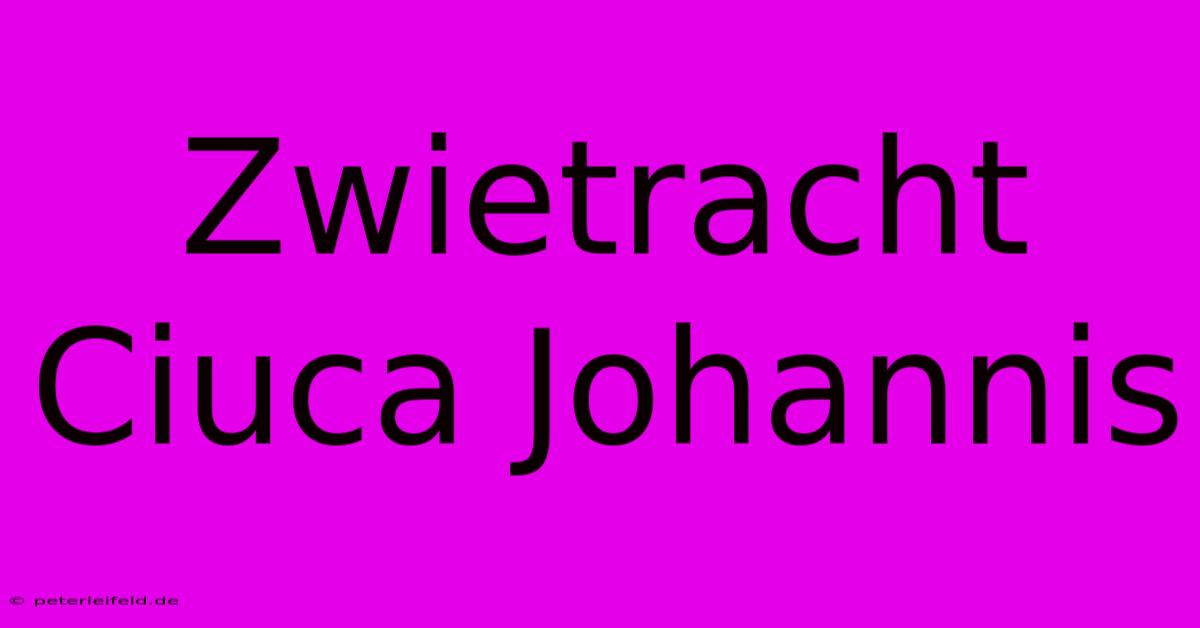Zwietracht Ciuca Johannis

Discover more detailed and exciting information on our website. Click the link below to start your adventure: Visit Best Website Zwietracht Ciuca Johannis. Don't miss out!
Table of Contents
Zwietracht Ciuca Johannis: My Very Winding Road to Understanding This Obscure Romanian Tradition
Okay, so, full disclosure: I almost messed this whole thing up. I thought I knew about Zwietracht Ciuca Johannis. I’d read a few super vague articles online—you know the type, filled with flowery language and almost no actual information? Yeah, those. Turns out, I was way off base. And that's why I'm here to share my experience and, hopefully, save you some heartache.
What is Zwietracht Ciuca Johannis? The Short (and Accurate) Version
First things first: Let's get the basics straight. Zwietracht Ciuca Johannis isn't some widely known, globally celebrated tradition. It's a very localized custom, primarily associated with the Transylvanian Saxon communities around Sibiu (Hermannstadt) and its surrounding villages. Think small, intimate celebrations, deeply rooted in their history and often involving unique, regional variations. It's basically a harvest festival, with a unique twist. The name itself points to a blend of German and Romanian influences, reflecting the complex history of the region. It's not easy to find accurate information online; trust me, I spent hours scouring obscure forums and dusty archives!
My Epic Fail (and How You Can Avoid It)
So, my initial research was… lacking, to put it mildly. I planned a trip to Sibiu, thinking I'd stumble upon this amazing, secret festival. I even bought a fancy Trachtendirndl (traditional Bavarian dress - oops, cultural faux pas number one!), picturing myself celebrating alongside locals. The reality? I spent most of my time wandering around Sibiu's beautiful medieval streets, utterly confused. I asked locals; they looked at me like I'd sprouted a second head.
Lesson learned: Don't rely solely on sketchy online sources. If you're interested in experiencing a specific, localized tradition like Zwietracht Ciuca Johannis, do your homework. I'm talking contacting local museums, historical societies, or even reaching out to tourism boards in the specific villages where these celebrations are known to happen. It's far more reliable than hoping for a happy accident!
Unearthing the Truth (and Some Amazing Insights)
After my initial blunder, I dug deeper. I contacted the Sibiu County Museum. I spent weeks looking at local historical archives and contacting cultural organizations. It was tedious, sure, but it was so rewarding. I discovered that Zwietracht Ciuca Johannis is more than just a celebration; it's a living testament to a rich cultural heritage. The specifics vary from village to village, often involving unique songs, dances, traditional food, and sometimes even ancient rituals. Think less organized festival, and more intimate community gathering.
Practical Tips for Your Own Zwietracht Ciuca Johannis Adventure
- Timing is key: These celebrations are often tied to specific agricultural cycles or religious holidays. Do your research to pinpoint the right time of year.
- Location, location, location: Don't just focus on Sibiu. Explore the smaller villages surrounding it. That’s where the real action—and the authentic traditions—are likely to be found.
- Learn some basic German and Romanian phrases: Even a few words can go a long way in showing respect and building connections with locals.
- Be respectful: These are not tourist attractions; they're deeply personal community events. Observe respectfully and avoid disruptive behavior.
- Embrace the unexpected: Things won't always go according to plan. Be flexible, and be prepared to adapt!
Ultimately, my journey to understand Zwietracht Ciuca Johannis taught me the importance of thorough research and the beauty of embracing the unexpected. It’s a lesson in patience and cultural sensitivity. And, honestly? Even without witnessing the festival itself, the journey of discovery was an adventure in itself. Now, if you'll excuse me, I'm going to go burn that Trachtendirndl. Don't ask.

Thank you for visiting our website wich cover about Zwietracht Ciuca Johannis. We hope the information provided has been useful to you. Feel free to contact us if you have any questions or need further assistance. See you next time and dont miss to bookmark.
Featured Posts
-
Stoeckl Skistoecke Qualitaet Und Auswahl
Nov 22, 2024
-
Neos Chefin Meinl Reisinger Ziele
Nov 22, 2024
-
Mitterdorfer Verlaesst Den Oe Fb
Nov 22, 2024
-
Krypto Prognose Bitcoin Statt Micro Strategy
Nov 22, 2024
-
Bitcoin Prognose Micro Strategy Ausstieg
Nov 22, 2024
